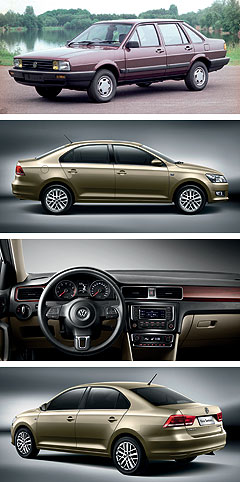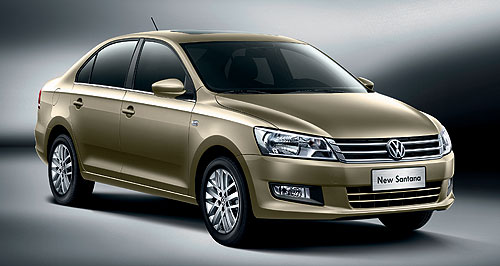Make / Model Search
Future models - Volkswagen - SantanaGuangzhou show: VW’s grandpa Santana put to restNew workhorse: Shanghai Volkswagen’s all-new Santana is set to take over from the original that has done duty since 1981. After three decades, all-new Volkswagen Santana arrives to replace Chinese veteran22 Nov 2012 ONE of the longest automotive production runs in history has come to an end with the venerable 31-year-old Volkswagen Santana about to be replaced in China by an all-new model publicly launched at this week’s Guangzhou motor show. The taxi of choice in Shanghai and government fleet vehicle for a legion of Chinese government officials, the outgoing Santana sedan – based on the second-generation Passat – has been in production with only mild updates since 1981. Almost four-million Santanas have been built at VW Shanghai, the joint venture between China’s biggest car-maker, Shanghai Automotive Industry Corporation, and Europe’s biggest motor company, Volkswagen AG. Although that pales into insignificance alongside the 21 million original VW Beetles built between 1938 and 2003, Santana’s long unbroken run places it firmly in the pantheon of significant cars. The Santana is widely regarded as the car that put China on wheels, in much the same way as the Beetle opened the door for widespread motoring in Germany (and the T-Model Ford in North America). It gave VW a massive foothold in the Chinese market, where it remains one of the biggest automotive marques today.  From top: 1986 Volkswagen Santana 2013 Volkswagen Santana. From top: 1986 Volkswagen Santana 2013 Volkswagen Santana.The first Santanas were assembled from CKD (completely knocked down) parts shipped from Europe to China by SAIC forerunner Shanghai Tractor Automobile Corporation. Mass production began at the newly formed Shanghai VW Automotive joint venture factory in 1984, initially with a 1.6-litre petrol engine. Although the Santana named was dropped in Europe in the 1980s, both the name and the car soldiered on in China, periodically updated with new engines and transmissions. Backed by the Communist Shanghai provincial government, Shanghai VW was the automatic choice for all manner of official transport purposes, including taxis, police cars and civic servant cars. As China’s middle class began to mobilise, the Santana became popular with private buyers, helping to make the sedan China’s top-selling car for years. The rise of more modern vehicles such as the VW Passat and Chevrolet Cruze in recent times spelled the end for the venerable Santana, now replaced by an all-new model. Oddly, the new model was unveiled at VW’s Wolfsburg headquarters in Germany – where it was designed and engineered – last month ahead of its public roll out at China’s second biggest annual auto show, in Guangzhou, today. Reportedly based on a stretched Polo platform and with styling reminiscent of the new Jetta, the new front-drive Santana has more rear kneeroom than the original, as well a bigger boot – key features for a car that is likely to do duty as a taxi. Two petrol engines are offered: a 1.4-litre petrol engine with 66kWof power and a combined fuel consumption of 5.9 litres per 100km, and a 1.6-litre with 81 kW and fuel consumption of 6.0l/100km. VW says fuel economy has been improved by up to 28 per cent. The decision to end Santana production in China comes less than one month after Volkswagen ended production of another iconic model – the Kombi people-mover – at its factory in Sao Bernardo del Campo in Brazil.  Read moreAll future modelsMotor industry news |
Click to shareVolkswagen modelsResearch Volkswagen All future modelsMotor industry news |


 Alfa Romeo
Alfa Romeo Abarth
Abarth Audi
Audi Aston Martin
Aston Martin BMW
BMW Bentley
Bentley Ferrari
Ferrari Chevrolet
Chevrolet Ford
Ford Fiat
Fiat GWM
GWM Foton
Foton Hyundai
Hyundai Honda
Honda Jaguar
Jaguar Isuzu
Isuzu Kia
Kia Jeep
Jeep Land Rover
Land Rover Lamborghini
Lamborghini Maserati
Maserati Lexus
Lexus McLaren
McLaren Mazda
Mazda Mercedes-Benz
Mercedes-Benz Mitsubishi
Mitsubishi Mini
Mini Peugeot
Peugeot Nissan
Nissan Ram
Ram Porsche
Porsche Rolls-Royce
Rolls-Royce Smart
Smart Skoda
Skoda Suzuki
Suzuki Subaru
Subaru Toyota
Toyota Tesla
Tesla Volvo
Volvo Zeekr
Zeekr







Facebook Twitter Instagram